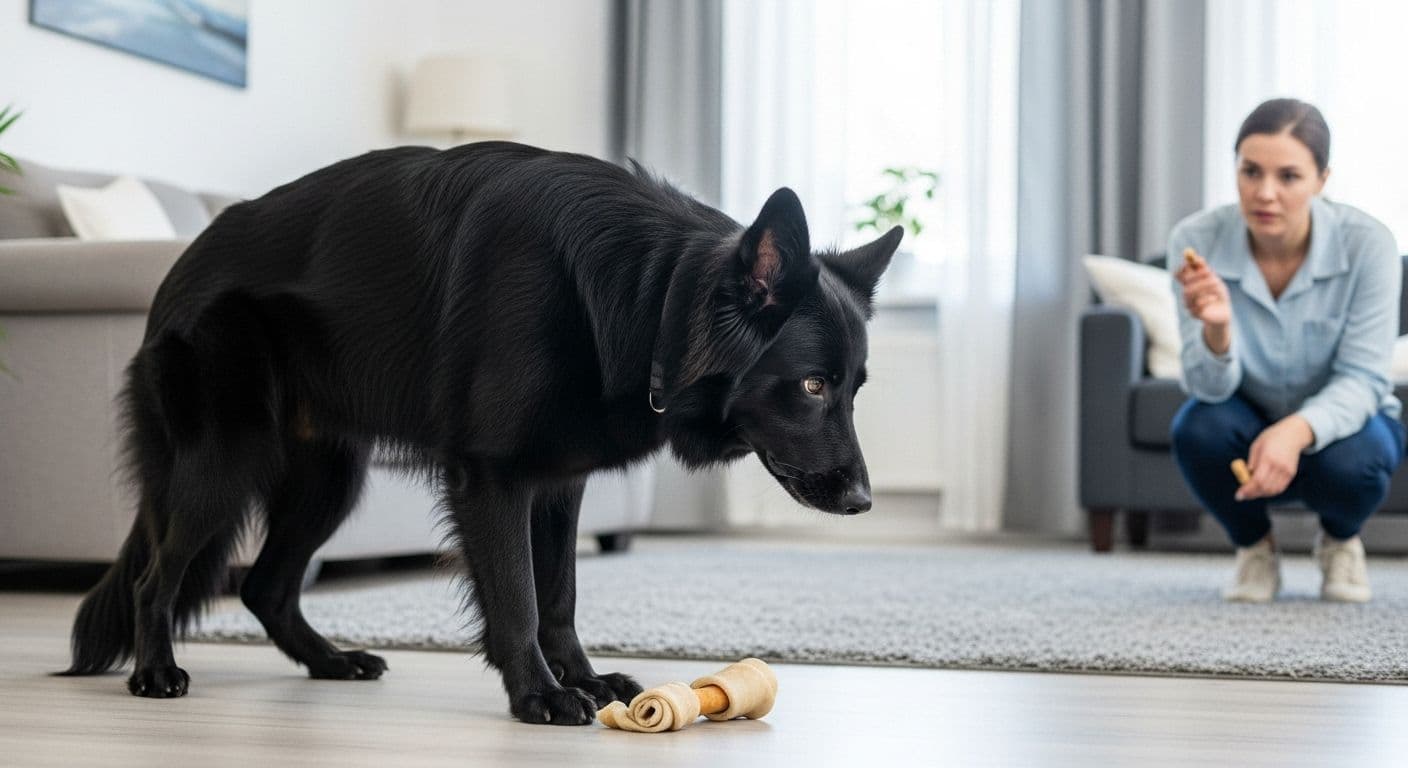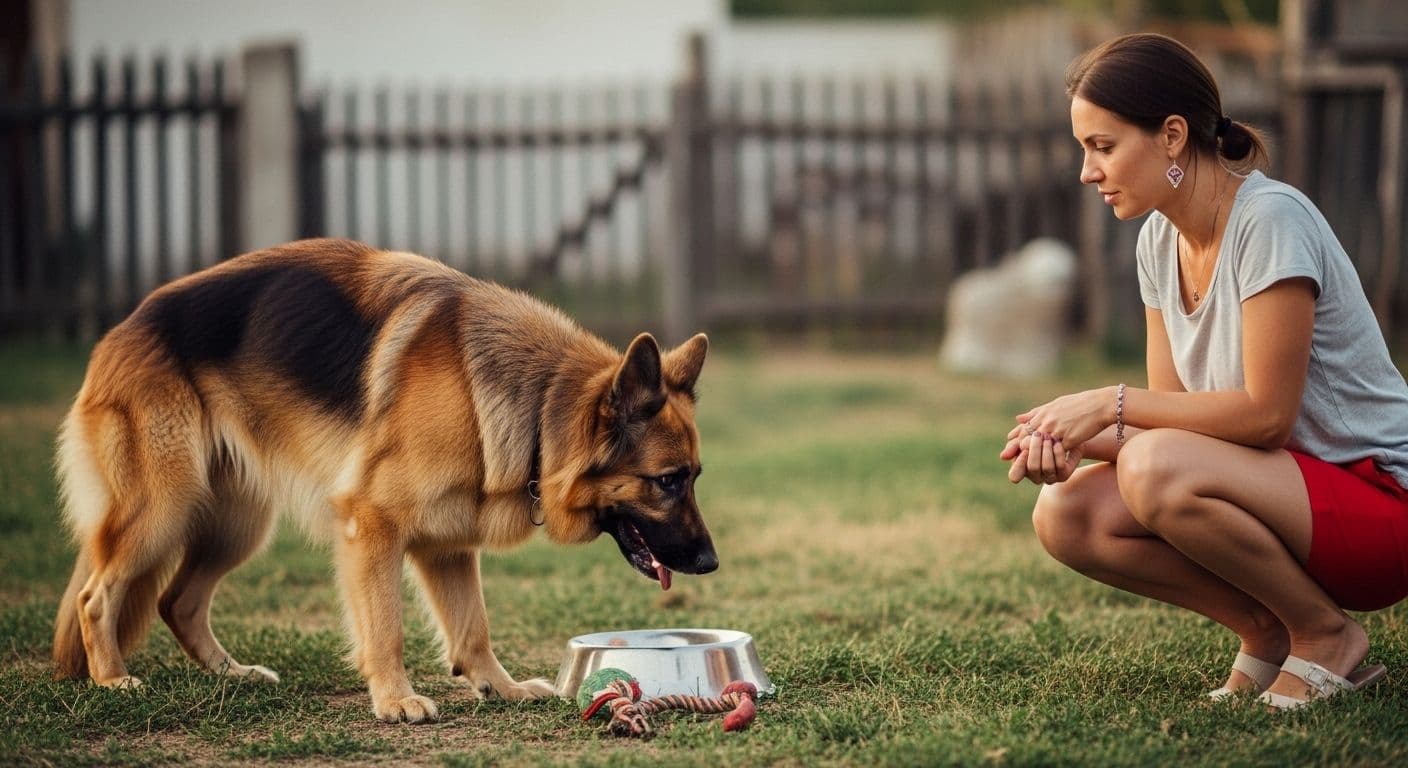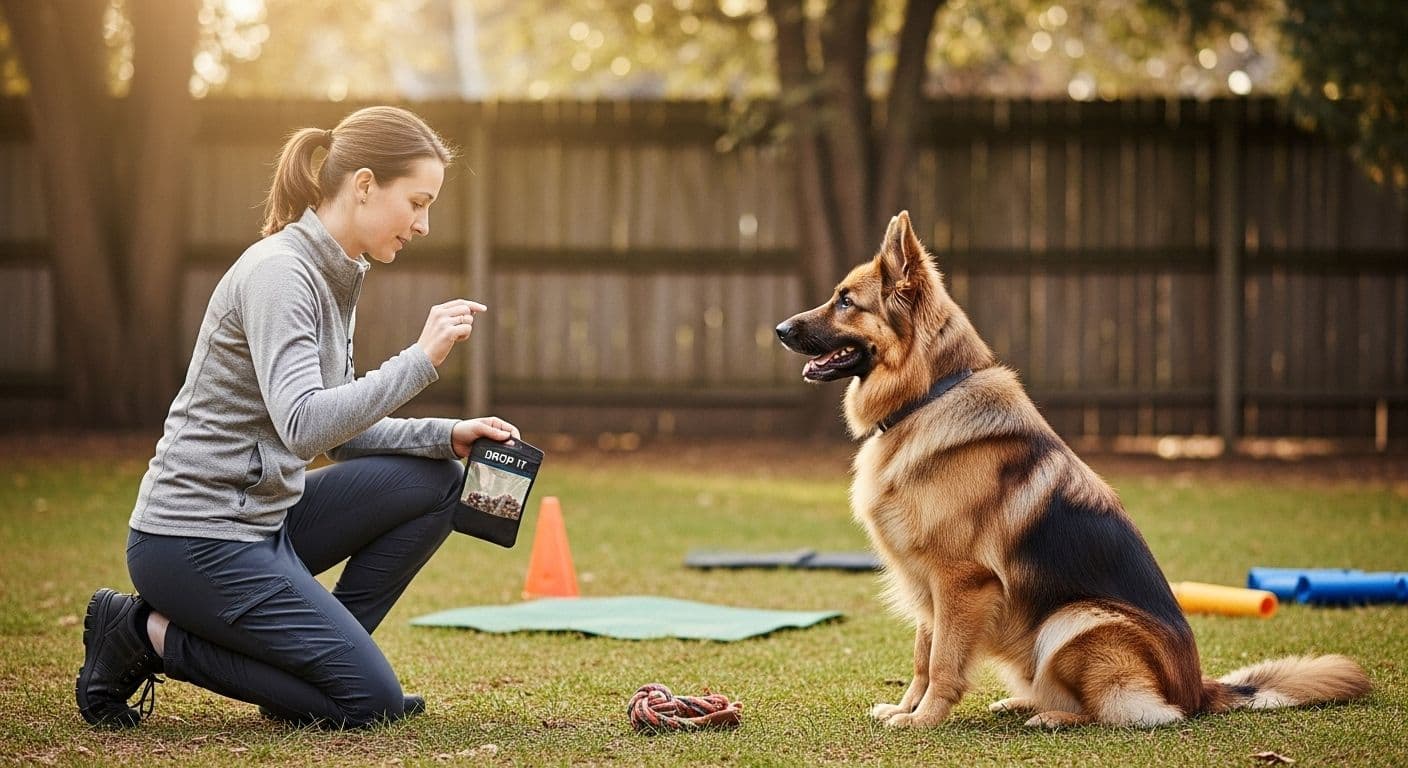It’s a scenario many dog owners know: you approach your dog, Buddy, who is happily chewing on a stolen sock. As you get closer, he freezes. His body stiffens, he gives you a hard stare, and a low growl rumbles in his chest. This is dog resource guarding in action—Buddy’s way of saying, “This is mine, stay away.”
Resource guarding is a natural survival instinct, but it can be a serious safety issue in a family home. Your first move is the most important: stop and step back. Respecting his warning is crucial for preventing a bite. The key to resolving this behavior isn't about showing him who's boss; it's about building trust through careful management and positive strategies.
This guide will walk you through what resource guarding looks like, why it happens, and how you can use humane, effective methods to create a safer, more trusting relationship with your dog.
Dog Resource Guarding: What It Looks Like and When to Worry

Recognizing resource guarding is the first step toward managing it. The signs can range from almost imperceptible tension to overt aggression, and understanding this progression is key to keeping everyone safe.
Spot the Signs
A dog’s warning signals are a form of communication designed to prevent a conflict from escalating. They often follow a predictable pattern:
- Subtle Tension: The dog may freeze, stiffen its body, give a "whale eye" (showing the whites of its eyes), or hover over the item.
- Audible Warnings: If the subtle signs are ignored, the dog may escalate to a low growl or a snarl, baring its teeth.
- Physical Action: The final stages include lunging, snapping (biting the air), or making contact with a bite.
What Dogs Guard
Dogs can guard anything they find valuable. Here’s what guarding can look like in different contexts:
- Food Bowls: Eating quickly, blocking the bowl with their body, or growling as you approach.
- Chews & Toys: Hiding items, stiffening when you get near, or running away to a "safe" spot.
- Beds & Resting Spots: Giving a hard stare or growling when someone approaches their favorite couch spot or bed.
- Doorways: Blocking access to a room or preventing a specific person from entering or leaving.
- Stolen Items: Running off with a forbidden item (like a sock or shoe) and growling if you try to retrieve it.
- A Favorite Human Being: Positioning themselves between their person and others, leaning on them, or growling when someone else gets too close.
Recognizing a Resource Guarding Dog vs. Normal Possessiveness or Play
Is your dog playing "keep away" or are they guarding? The difference lies in their body language and intensity.
- Resource Guarding: The dog's body is tense and stiff. They may show a hard stare, pinned ears, and a closed mouth. The behavior is defensive and escalates if you push.
- Playful Possessiveness: The dog's body is loose and wiggly. They might offer a play bow, have a soft expression, and seem to be inviting a game. The interaction is brief and part of a fun, back-and-forth exchange.
If the behavior makes you feel unsafe or tense, trust your gut. It’s likely not play.
Why Punishing "Warning Signals" Can Escalate Risk
It can be tempting to scold a dog for growling, but this is one of the most dangerous mistakes an owner can make.
A growl is a crucial piece of communication. It’s your dog’s way of saying, “I’m uncomfortable, please give me space.” Punishing the growl doesn’t fix the underlying fear—it just teaches the dog not to warn you next time. This can create a dog that bites without any apparent warning.
Instead of punishment, respect the signal by calmly increasing distance and then work on changing your dog’s emotional response through positive training.
Why Dogs Guard Resources

Understanding the "why" behind resource guarding helps you address it with empathy and effective strategies. The behavior is often rooted in a mix of instinct, life experience, and environmental factors.
Survival Instincts, Genetics, Early Scarcity, and Lack of Socialization
Guarding resources is an evolved survival drive. In the wild, protecting food or shelter meant staying alive. This instinct can be amplified by:
- Genetics: Some breeds or family lines may have a stronger genetic predisposition for guarding behaviors.
- Early Scarcity: A rescue dog that once had to compete for food may guard their bowl anxiously, even in a home with plenty of resources.
- Lack of Socialization: A dog with limited positive exposure to people or other animals may view them as competitors or threats, triggering guarding.
Common Triggers
Certain actions can inadvertently trigger a guarding response. Common triggers include:
- Approaching a dog quickly while it's eating or has a high-value chew.
- Reaching for or leaning over the dog and its treasured item.
- Attempting to forcibly take an item away.
- Staring directly at the dog.
- Another pet approaching while the dog has food or a toy.
Family Dynamics
The home environment plays a significant role. Risks increase in certain situations:
- Multi-Dog Homes: Competition over food, toys, or attention can lead to tension and fights.
- Households with Kids: Children’s unpredictable movements and inability to read dog body language can provoke a defensive reaction.
- Frequent Visitors: Unfamiliar people can disrupt routines and make a dog feel anxious or territorial.
- Dog Resource Guarding Owner: When a dog treats a person like a high-value resource, it can lead to aggression toward anyone who approaches that person. This is particularly high-risk and requires immediate professional guidance.
Stress, Pain, and Medical Issues That Can Fuel Guarding
A sudden onset of guarding behavior always warrants a trip to the vet. Pain and medical conditions can lower a dog’s tolerance and increase irritability.
- Arthritis or Injury: A dog may guard its bed because lying down is painful.
- Dental Pain: A dog might guard its food bowl if chewing is uncomfortable.
- Hypothyroidism: This hormonal imbalance can sometimes lead to increased anxiety and aggression.
Before starting any training plan, it’s essential to have your vet perform a comprehensive exam—including blood work and a pain assessment—to rule out any underlying medical contributors.
Resource Guarding Training That Works (Humane and Effective)
How to STOP “Food Aggression”/ Resource Guarding in Dogs- WITHOUT FORCE
Effective resource guarding training focuses on changing your dog's feelings about you approaching their valuables, not on confrontation. The goal is to teach your dog that your presence predicts good things, not threats.
Management First
Management is your first line of defense. It prevents the dog from rehearsing the guarding behavior, which makes it stronger.
- Safe Feeding Stations: Feed your dog in a separate room or a crate to prevent anyone from disturbing them.
- Use Barriers: Baby gates are perfect for creating dog-free zones, especially during mealtimes or when guests are over.
- Trade, Don't Take: If your dog has something they shouldn't, offer them a high-value treat in exchange. Never forcibly snatch an item from their mouth.
- Muzzle Training: For severe cases, positively conditioning your dog to wear a basket muzzle is a responsible safety tool for vet visits or other unavoidable triggers.
Desensitization and Counterconditioning
This is the core of dog training for resource guarding. The goal is to slowly change your dog’s emotional response from fear to positive anticipation.
- Approach-and-Toss: From a distance your dog is comfortable with, walk toward their food bowl and toss a high-value treat (like chicken) near them, then walk away. Over many sessions, you can gradually decrease the distance.
- Teach "Drop It": Start by trading a low-value toy for a tasty treat. Say "Drop It" as they release the toy. Practice often so they learn that giving things up results in a reward.
- Teach "Give": This cue teaches a dog to voluntarily place an item in your hand. This is an advanced skill built on trust and positive reinforcement.
- Two-Bowl Protocol: This pattern game teaches a dog to move calmly between two bowls for treats, building focus and relaxation even when a trigger is present nearby.
Dog Resource Guarding a Favorite Human Being
When a dog is dog resource guarding a favorite human being, the training needs to be very structured.
- Teach a "Place" Cue: Train your dog to go to a mat or bed on command. Use this to create space when others approach.
- Manage Greetings: When someone approaches the guarded person, have them toss a high-value treat to the dog on its mat and then leave. This builds a positive association.
- Spread the Love: Have other family members take over some feeding, walking, and training duties to show the dog that good things come from everyone, not just one person.
Reinforcement Strategies for Food, Toys, and Space Guarding
Success in dog resource guarding training hinges on building trust.
- Be Predictable: Create consistent routines for feeding, play, and rest.
- Provide Abundance: In multi-dog homes, make sure there are plenty of toys and beds to reduce competition.
- Use High-Value Rewards: When practicing, use extra-special treats to make the experience positive.
- Respect Their Space: Give your dog space when they are eating or chewing a high-value item.
Mistakes to Avoid
Outdated training methods based on dominance and intimidation will make resource guarding worse and can provoke a bite.
- Don't Use Intimidation: Yelling at, staring down, or physically forcing your dog will only increase their fear and anxiety.
- Avoid "Alpha Rolls": Forcibly rolling a dog on its back is dangerous and based on debunked theories. It destroys trust.
- Never Snatch Items: This teaches your dog that you are a threat to their resources, confirming their need to guard them more fiercely. Effective resource guarding dog training is built on cooperation, not conflict.
When to Hire Dog Trainers for Resource Guarding
While mild cases can sometimes be managed by owners, resource guarding can be dangerous. Knowing when to call for professional help is critical for everyone's safety.
Red Flags for Professional Help
It's time to hire a professional if you see any of these signs:
- The dog has nipped, snapped, or bitten anyone.
- The guarding is escalating in intensity or frequency.
- There are children in the home.
- The dog is guarding space (like a room or hallway) or a person.
- You feel worried, unsafe, or unable to manage the situation.
While you wait for an appointment, prioritize safety. Use management tools like baby gates, crates, and leashes to completely avoid trigger situations.
Finding Qualified Help
Look for a certified professional who uses modern, science-based methods. Avoid trainers who talk about "dominance," "pack leadership," or use punishment-based tools like prong or shock collars.
Good places to search for qualified trainers include:
- International Association of Animal Behavior Consultants (IAABC)
- Karen Pryor Academy (KPA)
- Certification Council for Professional Dog Trainers (CCPDT)
When interviewing potential dog trainers for resource guarding, ask what happens when the dog gets it right and what happens when the dog gets it wrong. A good trainer will focus on rewarding correct choices and managing the environment to prevent mistakes, not on punishing errors.
What a Training Plan Looks Like

A professional plan will be customized but generally includes:
- Assessment: A thorough history to identify triggers and severity.
- Management Plan: Immediate steps to ensure safety and prevent the behavior from continuing.
- Behavior Modification: A step-by-step desensitization and counterconditioning (DS/CC) protocol.
- Foundation Skills: Teaching cues like "drop it" and "place."
Be realistic with timelines. Mild cases may improve in a few weeks, but severe guarding can take months of consistent work and may require lifelong management. In some cases, a veterinary behaviorist may recommend anti-anxiety medication to support the training plan.
How Owners Can Support Progress Between Sessions
Your "homework" is the most important part of the training.
- Keep a Log: Track training sessions, noting triggers, distances, and your dog's reaction.
- Short & Sweet Sessions: Practice for just 5-10 minutes, a few times a day.
- Use Video: Send short videos to your trainer so they can provide feedback between sessions.
- Stay Consistent: Ensure everyone in the household follows the management and training plan.
Keep Progress Going
Long-term success depends on integrating new habits into your daily life. The goal is to create a predictable, low-conflict environment for your resource guarding dogs.
Routines That Reduce Conflict in Resource Guarding Dogs
- Provide Enrichment: A tired, mentally stimulated dog is less likely to be anxious. Use food puzzles, training games, and sniffy walks to keep their mind engaged.
- Establish Predictable Routines: Consistent feeding times and daily schedules help reduce stress.
- Create a "Trade Culture": Make trading a normal part of your life. Regularly trade up for better items to reinforce that giving things to you is always a good deal.
Household Rules for Kids and Guests
Clear rules are essential for safety.
For Kids: Always supervise interactions. Teach children to never approach a dog that is eating, sleeping, or chewing on a toy. A "Be a Tree" stance (standing still, arms folded) is a safe way to respond if a dog seems overexcited.
For Guests: Use gates or leashes to manage interactions. Ask guests to let your dog approach them and to avoid reaching for or petting the dog unless you give them the okay.
For Multi-Dog Homes: Feed dogs in separate rooms or crates. Pick up bowls right after meals. Do not leave high-value items like bones out when dogs are together unsupervised.
Tracking Progress, Troubleshooting Plateaus, and When to Reassess
Progress isn't always linear. Track measurable criteria to stay motivated:
- Distance Tolerance: Can your dog stay calm with you one step closer than last week?
- Latency to Relax: Does your dog relax more quickly after seeing a trigger?
- Fewer Incidents: Are you having fewer guarding events overall?
If you hit a plateau, go back to a step where you were successful. If the behavior worsens or you see aggression, it's time to reassess with your trainer or a veterinary behaviorist.
Living with dog resource guarding can be stressful, but it is manageable. By focusing on compassion, consistency, and safety, you can build a stronger, more trusting bond with your dog. Remember, you are not alone—professional support is available to guide you through the process and ensure the best possible outcome for both you and your beloved companion.



